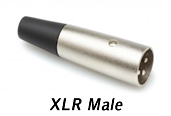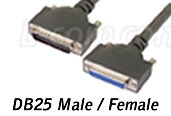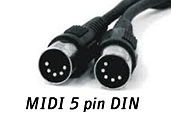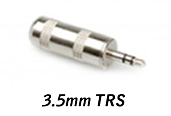| |
|
|
|
|
|
|
|
|
|

|
|
|
This is a compilation of audio terms. We hope you find this document useful!
|
|
A
|
A/D Converter
An Analog to Digital Converter (ADC) is an electronic device whose function is to convert signals from the analog domain into digital data. The data can then be recorded and manipulated within a computer audio workstation or stand alone digital recorder.
|
|
|
Active crossover
based on integrated circuits (ICs), discreet transistors or tubes. An active crossover is impedance buffered and gives a consistent and accurate transition regardless of load.
|
|
|
ADAT
Alesis Digital Audio Tape. "ADAT" is also used as an abbreviation for the ADAT Lightpipe protocol, which transfers 8 tracks and/or channels in a single fiber optic cable.
|
|
|
AES/EBU
Officially known as AES3. Balanced digital connection used for carrying digital audio signals between various digital devices. The AES/EBU standard uses 110ohm cable terminated in either an XLRtype connector or 25-pin D-Sub.
|
  
|
|
|
Amplifier (Amp)
A device that increases signal level. Many types of amplifiers are used in audio systems. Amplifiers typically increase voltage, current or both.
|
|
|
Analog
Before digital, the way all sound was reproduced. An analog signal theoretically has an infinite resolution and will always have a higher resolution than digital systems where the resolution is in discrete steps.
|
|
|
ATTENUATION
The reduction in level of a signal.
|
|
|
Aux-send
A feature of a professional multi-channel sound mixing console which provides an effects loop, allowing the level control of outboard audio processing to be added to either an audio source, channel or group of channels within the mixing console. This feature is typically found on mixing consoles that are used in recording, concert and broadcasting.
|
| |
AVB (Audio Video Bridging)
AVB
is a common name for the set of technical standards developed by the Institute of Electrical and Electronics Engineers (IEEE). Provides the specifications that will allow time-synchronized low latency streaming services.
|
|
B
|
Balanced
Referring to wiring: Audio signals require two wires. In an unbalanced line the shield is one of those wires. In a balanced line, there are two wires plus the shield. For the system to be balanced it requires balanced electronics and usually employs either an XLR, 1⁄4” TRS or in some cases a 25-pin D-Sub connector. Balanced lines are less apt to pick up external noise. This is usually not a factor in home audio, but is a factor in professional audio requiring hundreds or even thousands of feet of cabling.
|
 
 
|
|
|
Banana Plug
A connector that is designed primarily for connecting speaker wire to the binding posts on the back of power amplifiers.
|

|
|
|
Bandwidth
The total frequency range of any system. Usually specified as something like 20-20,000Hz plus or minus 3 dB.
|
|
|
Bi-amplify
The use of two amplifiers, one for the low frequencies, one for the high frequencies in a speaker system. Could be built into the speaker design or accomplished with the use of external amplifiers and electronic crossovers. (see electronic crossover)
|
|
|
Bit Rate
The ratio of the number of bits that are transferred between devices in a specified amount of time, typically one second. Bit rate is the same as data rate, data transfer rate and bit time.
|
|
|
BNC
A type of connection often used in instrumentation and sometimes in digital audio. BNC connectors sometimes are used for digital connections such as Word Clock I/O connection. It is also used for antennas in wireless systems and in video to carry clock signals.
|

|
|
|
Bridging
Combining both left and right stereo channels on an amplifier into one higher powered mono channel. When an amplifier is bridged, the impedance that the amplifier actually "sees" is calculated based upon the output of both stereo channels.
|
|
|
Bus (Or subgroup)
A signal from a channel can be either summed to create the main mix, or combined on a bus as a submix, a group of channels that are then added to get the final mix (for instance, many drum mics could be grouped into a bus, and then the proportion of drums in the final mix can be controlled with one bus fader).
|
|
C
|
Clipping
Refers to a type of distortion that occurs when an amplifier is driven into an overload condition. Usually the "clipped" waveform contains an excess of high-frequency energy. The sound becomes hard and edgy. Hard clipping is the most frequent cause of "burned out" tweeters. Even a low-powered amplifier or receiver driven into clipping can damage tweeters which would otherwise last virtually forever.
|
|
|
Compression
Dynamic processor. In audio, compression means to reduce the dynamic range of a signal. Usually applied at an insert point on a mixing console.
|
|
|
Crossover
A frequency divider. Crossovers are used in speakers to route the various frequency ranges to the appropriate drivers. Additionally, many crossovers contain various filters to stabilize the impedance load of the speaker and or shape the frequency response. Some crossovers contain levels controls to attenuate various parts of the signal.
|
|
|
Cross-talk
Unwanted breakthrough of one channel into another. Also refers to the distortion that occurs when some signal from a music source that you are not listening to leaks into the circuit of the source that you are listening to.
|
|
D
|
DAC
A Digital to Audio Converter. Converts a digital bitstream to an analog signal and visa versa. Can be either a separate external box or internal circuit.
|
| |
Dante
Digital Audio Network Through Ethernet, a combination of software, hardware and network protocols. Delivers uncompressed, multichannel digital audio over standard Ethernet network.
|
|
|
D/A Converter
Digital to Analog converter. The opposite of an A/D converter; where audio signals in the form of digital data are converted into an analog waveform.
|
|
|
Decibel (dB)
Named after Alexander Graham Bell. We perceive differences in volume level in a logarithmic manner. Our ears become less sensitive to sound as its intensity increases. Decibels are a logarithmic scale of relative loudness. A difference of approx. 1 dB is the minimum perceptible change in volume, 3 dB is a moderate change in volume, and about 10 dB is an apparent doubling of volume
- 0 dB is the threshold of hearing, 130 dB is the threshold of pain.
- Whisper 15-25 dB
- Quiet background about 35 dB
- Normal home or office background 40-60 dB
- Normal speaking voice 65-70 dB
- Orchestral climax 105 dB
- Live Rock music 120 dB+
- Jet aircraft 140-180 dB
|
|
|
Digital Audio Workstation (DAW)
is a system designed to record, edit and play back digital audio. A key feature of DAWs is the ability to freely manipulate recorded sounds, much like a word processor manipulates typed words.
|
|
|
Direct Box
Also known as a DI box, is either an active or passive device that enables a musical instrument (guitar, etc.) to be connected directly to a mic- or line-level mixer input. The box provides the very high input impedance required by the instrument and puts out the correct level for the mixer.
|
|
|
Distributed speaker systems
Refers to networks of loudspeakers which are connected to an audio amplifier utilizing step-up and step-down transformers to simplify impedance calculations and to minimize power loss over the speaker cables. In the US, they are most commonly referred to as "70-volt speaker systems".
|
|
|
Distortion
Anything that alters the musical signal. There are many forms of distortion, some of which are more audible than others. Distortion specs are often given for electronic equipment which are quite meaningless. As in all specifications, unless you have a thorough understanding of the whole situation, you will not be able to make conclusions about the sonic consequences.
|
| |
DMX:
(Digital Multiplex) Originally intended as a standardized method for controlling light dimmers. Communicates on 3 pin XLR, 110-ohm cable.
DMX512:
Primary method of communication between controllers (lighting consoles/software) to dimmer packs, intelligent lights and special effect devices (lasers, moving heads, fog machines, etc.) Communicates on either 3 or 5 pin XLR, 110-ohm cable.
|
|
|
DSP
Digital Signal Processing. DSP can be used to create reverbs, echo, phasing etc. of a digital signal.
|
|
|
Dynamic range
The range between the loudest and the softest sounds that are in a piece of music, or that can be reproduced by a piece of audio equipment without distortion (a ratio expressed in decibels). In speech, the range rarely exceeds 40 dB; in music, it is greatest in orchestral works, where the range may be as much as 75 dB.
|
| |
Dynamic Processors:
Compressors/Limiters and Gates, control dynamic range by reducing loud sounds, amplifying sounds and sets Thresholds for passing sound through the system. |
|
E
|
Efficiency rating
The loudspeaker parameter that gives the level of sound output when measured at a prescribed distance with a standard level of electrical energy fed into the speaker.
|
|
|
Electronic Crossover
Uses active circuitry to send signals to appropriate drivers. More efficient than passive crossovers.
|
| |
EMI Electromagnetic interference
EMI is a disturbance generated by an external source that affects an electrical circuit by electromagnetic induction, electrostatic coupling, or conduction. Both man-made and natural sources generate changing electrical currents and voltages that can cause EMI. |
|
|
Equalizer
Electronic set of filters used to boost or cut (attenuate) certain frequencies.
|
|
F
|
Feedback
In acoustics, the undesirable leakage of audio from loudspeakers, back into the same microphone which is used for the original capture the audio. If too much feedback occurs, the system can go into self-oscillation, causing unpleasant howling or squealing.
|
|
|
FireWire
Apple/Macintosh brand name for the IEEE 1394 interface. It is also known as i.Link (Sony). It has become the personal computer, digital audio and digital video serial bus interface standard, offering high-speed communications and real-time data services. FireWire has replaced Parallel SCSI in many applications. FireWire is also available in wireless, fiber optic and coaxial versions. Many computers intended for home or professional audio/video use, have built-in FireWire ports including all Apple/Mac, Sony laptop computers along with most Dell and HP models currently produced.
|

|
|
|
Flat Response
The faithful reproduction of an audio signal; specifically, the variations in output level of less than 1 dB above or below a median level over the audio spectrum.
|
|
|
Frequency
The range of human hearing is commonly given as 20-20,000Hz (20Hz-20kHz). One hertz (Hz) represents one cycle per second, 20Hz represents 20 cycles per second and so on. Lower numbers are lower frequencies
|
|
|
Full-range
A speaker designed to reproduce all or most of the sound spectrum.
|
|
G
|
Gain
To increase in level. The function of a volume control.
|
|
|
Gate
Dynamic processor. A device that has the ability to stop audio passing through it based on an assignable threshold. Usually applied at an insert point on a mixing console.
|
|
H
|
Harmonics
Also called overtones, these are vibrations at frequencies that are multiples of the fundamental. Harmonics extend without limit beyond the audible range. They are characterized as even-order and odd-order harmonics. A second-order harmonic is two times the frequency of the fundamental; a third order is three times the fundamental; a fourth order is four times the fundamental; and so forth. Each even-order harmonic second, fourth, sixth, etc.-is one octave or multiples of one octave higher than the fundamental; these even-order overtones are therefore musically related to the fundamental. Odd-order harmonics, on the other hand third, fifth, seventh, and up-create a series of notes that are not related to any octave overtones and therefore may have an unpleasant sound. Audio equipment that emphasize odd-order harmonics tend to have a harsh, hard quality.
|
|
|
Hertz (Hz)
A unit of measurement denoting frequency, originally measured as Cycles Per Second, (CPS) 20 Hz = 20 CPS. Kilohertz (kHz) are hertz measured in multiples of 1,000.
|
|
|
High-Pass Filter
A circuit that allows high frequencies to pass but rolls off the low frequencies. When adding a subwoofer it is often desirable to roll-off the low frequencies to the main amplifiers and speakers. This will allow the main speakers to play louder with less distortion. High-pass filters used at speaker level are usually not very effective unless properly designed for a specific main speaker (see impedance below).
|
| I |
IEEE
The Institute of Electrical and Electronics Engineers (IEEE, pronounced I triple E), is the world's largest association of technical professionals. Its objectives are the education and technical advancements in electronic and electrical, telecommunications, computer, etc. |
|
|
Imaging
Listening term. A good stereo system can provide a stereo image that has width, depth and height. The best imaging systems will define a nearly holographic re-creation of the original sound
|
|
|
Impedance
Impedance is a measure of electrical resistance specified in ohms. Speakers are commonly listed as 4 or 8 ohms but speakers are reactive devices and a nominal 8 ohm speaker might measure from below 4 ohms to 60 or more ohms over its frequency range. This varying impedance curve is different for each speaker model and makes it impossible to design a really effective "generic" speaker level high-pass filter. Active devices like amplifiers typically have an input impedance between about 10,000-100,000 ohms and the impedance is the same regardless of frequency.
|
|
|
Insert
An access point built into the mixing console, allowing the user to add external line level devices into the signal flow between the microphone preamp and the mix bus. Common usages includes gating, compressing, limiting, equalization and for reverb effects that are specific to that channel or group. Inserts can be used as an alternate way to route signals such as for multi-track recording output or line level direct input.
|
|
|
I/O
Abbreviation for input/output.
|
|
L
|
Latency
The time delay in digital audio systems due to analog to digital conversions, processing and conversion back to analog.
|
| |
Limiter:
A compressor with a high ratio and, generally, a fast attack time. A safety device in live sound and broadcast applications that prevents sudden volume spikes. |
|
|
Line Level
CD players, Cassette, MP3 players etc., are connected in a system at line level, usually with shielded RCA, 1⁄4” and in some cases balanced XLR and 1⁄4” TRS type interconnects. Line level is before power amplification. An output at a level is sufficient to drive the input of a power amplifier.
|
|
|
Low Frequency Extension
Good bass reproduction requires moving a lot of air and playback at realistic volumes. When adding a subwoofer, the rule is; you will need to move four times the air to go down one octave.
|
|
|
Low-Pass Filter
A circuit that allows low frequencies to pass but rolls off the high frequencies. Most subwoofers have low-pass filters built in and many surround sound decoders have subwoofer outputs that have been low-pass filtered.
|
|
|
Loudness
Perceived volume. Loudness can be deceiving. For example, adding distortion will make a given volume level seem louder than it actually is.
|
| |
MADI
Multichannel Audio Digital Interface or AES10. Supports Serial Digital Transmission over co-ax cable or Toslink lines of 28, 56 or 64 channels, up to 96kHz 24 bits per channel. |
|
M
|
Microphone
Sometimes referred to as a mic is an acoustic to electric transducer or sensor that converts sound into an electrical signal.
|
|
|
MIDI (Musical Instrument Digital Interface)
An industry-standard protocol that enables electronic musical instruments, computers and other equipment to communicate, control and synchronize with each other.
|

|
|
|
Muting
To greatly decrease the volume level, allowing the volume level to be cut way down without changing the master volume control.
|
|
N
|
Nonlinearity
What goes into a system comes out changed by its passage through that system-in other words, distorted. The ideal of an audio component and an audio system is to be linear, or non-distorting, with the image on one side of the mirror identical to the image on the other side.
|
|
O
|
Octave
An octave is a doubling or halving of frequency. 20Hz-40Hz is often considered the bottom octave. Each octave you add on the bottom requires that your speakers move four times as much air!
|
|
|
Ohm
A unit of electrical resistance or impedance.
|
|
|
Ohm's Law
The basic law of electric circuits. It states that the current [I] in amperes in a circuit is equal to the voltage [E] in volts divided by the resistance [R] in ohms; thus, I = E/R.
|
|
|
Output
The jack or physical location from which a device sends out a signal. A signal put out by a device. The sound level produced by a loudspeaker.
|
|
P
|
Pad or attenuator pad.
A passive network that reduces either the voltage or power level of a signal. A pad may also provide impedance matching.
|
|
|
Parametric equalizer
(or parametric "EQ") is an electronic multi-band variable equalizer device used in sound recording and live sound reproduction with Public Address systems ("PA systems"). Parametric equalization devices allow audio engineers to control the parameters of the internal band-pass filter sections (amplitude center frequency and bandwidth). The amplitude of each band can be controlled, and the center frequency can be shifted, and can be either widened or narrowed.
|
|
|
Passive Crossover
Uses inductors (coils) and capacitors to direct proper frequencies to appropriate drivers. These crossover systems can be simple (First Order = 1 component @ -6 dB/octave slope) to complex (Fourth Order = 4 components @ -24 dB/octave slope).
|
|
|
Peak
The maximum amplitude of a voltage or current.
|
|
|
Peak power rating
Another meaningless specification unless references are given.
|
|
|
Peak-to-Peak power rating
See above.
|
|
|
Phantom power
(labeled as +48 V on some audio equipment) is a method that sends a DC electrical voltage through microphone cables. It is best known as a common power source for condenser microphones.
|
| |
Phoenix Connector
AKA Euroblock or Combicon. Low Voltage, solderless, pluggable connector using screw terminals. |
  |
|
|
POST
(after) on a mixer; post indicates that the function is derived after the channel slider/fader or gain control.
|
|
|
Power (P)
The time rate of doing work or the rate at which energy is used.
|
|
|
PRE
(before) On a mixer, pre fade listen (PFL) indicates that the function is derived before the channel slider/fader or gain control pre monitor send, the monitor send is before and independent of the channel slider/fader or gain control. A pre monitor send is usually pre channel EQ also.
|
|
|
Pre-amplifier
Or Pre-amp is a device that takes a source signal, such as from a turntable, CD player, musical instrument, microphone and passes this signal on to a power-amplifier(s). The pre-amp may have a number of controls such as source selector switches, balance, volume and possibly EQ or tone-controls.
|
|
|
PFL
Pre Fade Listen. A button that permits a channel or sub to be monitored before that channel or sub's level control or fader.
|
|
R
|
RCA Connector
" Phono" plugs, used primarily as low-level connections between Phonographs/CD players/Tuners/Amplifiers, etc.
|

|
| |
RDM
Remote Device Management protocol sits on top of the normal DMX512 standard. With an RDM controller and RDM "enable" fixtures a DMX512 system goes from a unidirectional protocol to a bi-directional (half-duplex) system. The controller can send, GET and SET commands to devices on the wire covering all the everyday tasks a lighting system, i.e., device query, setting DMX addresses, modes, monitoring sensors, usage, status messages, fault finding etc.
|
| |
RFI (Radio Frequency Interference)
RFI is unwanted noise generated by almost all electronic and electrical devices. Any electronic device that generates radio frequency energy greater than 10 kHz must comply with international safety requirements. |
|
|
RMS (root-mean-square)
The square root of the mean of the sum of the squares. Commonly used as the effective value of measuring a sine wave's electrical power. A standard in amplifier measurements.
|
|
S
|
Sampling Rate
Also called a sample rate. Typically expressed in samples per second, or hertz (Hz), the rate at which samples of an analog signal are taken in order to be converted into digital form. A higher sampling rate provides a better quality reproduction than a lower sampling rate.
|
| |
SDI
Serial Digital Interface (SDI) is a standard for digital video transmission over 75 ohm coaxial cable.
|
|
|
SEND
An output used to patch a signal from a channel or Bus of a mixer to an external signal processor such as an echo or digital delay.
|
|
|
Signal-to-noise (SN) Ratio
The range or distance between the noise floor (the noise level of the equipment itself) and the music signal.
|
| |
SMPTE Timecode
Society of Motion Picture and Television Engineers was developed for film, video or audio material Time codes may use a number of frame rates. Common ones are: • 24 frame/sec (film) • 25 frame/sec (PAL) • 29.97 (30 ÷ 1.001) frame/sec (drop frame) (Color Video) • 30 frame/sec |
|
|
Sound Pressure Level (Spl)
Given in decibels (DB) is an expression of loudness or volume. A 10db increase in SPL represents a doubling in volume. Live orchestral music reaches brief peaks in the 105db range and live rock easily goes over 120db.
|
|
|
S/PDIF
Short for Sony/Philips Digital Interface, a standard audio file transfer format. Developed jointly by the Sony and Phillips corporations, S/PDIF allows the transfer of digital audio signals from one device to another without having to be converted first to an analog format. Maintaining the viability of a digital signal prevents the quality of the signal from degrading when it is converted to analog.
|
|
|
Speakon
A type of cable connector mostly used in pro audio systems for connecting loudspeakers to amplifiers.
|

|
| T |
TDIF
TASCAM Digital Interface. Terminated at a DB25 connector in groups of 8 channels per 25 pin connector. Supports up to 24 bit, 96KHz. |
|
|
TOSLINK
A standardized fiber optical connection system. Its most common use is in consumer audio equipment (via a "digital optical" socket), where it carries a digital audio stream between components such as MiniDisc, CD players, DAT player/recorders and other digital devices. TOSLINK was originally created by Toshiba.
|

|
|
|
Total harmonic distortion (THD)
Refers to a device adding harmonics that were not in the original signal. For example a device that is fed a 20Hz sine wave that is also putting out 40Hz, 80Hz etc.
|
|
|
TRS
Based off both the 1⁄4” and 3.5mm plugs, the connector's name is an acronym derived from the names of three conducting parts of the plug Tip, Ring, and Sleeve – hence, TRS, also called or phone plug is a common audio connector. Can be used to either interconnect balanced mic/line audio in a system or carry a stereo audio signal.
|
 
|
| V |
VCA
Voltage Control Amplifier is a variable-gain amplifier that is digitally controlled. |
|
W
|
Wattage
Is the unit of power used to rate the output of audio amplifiers. For a wattage number to have meaning the distortion level and impedance must also be specified.
|
|
|
Word clock or wordclock
(sometimes sample clock, which can have a broader meaning) is a clock signal (not the actual device) used to synchronize other devices, such as digital audio tape machines and compact disc players, which interconnect via digital audio. S/PDIF, AES/EBU, ADAT, TDIF and other formats use a word clock. The device which maintains the word clock on a network is the master clock.
|
|
X
|
XLR
XLR plugs and sockets are used mostly in professional audio and video electronics cabling applications. Home audio and video electronics normally use RCA connectors. In reference to its original manufacturer, Cannon, the connector is colloquially known as a cannon plug or canon. Originally the "Cannon X" series, subsequent versions added a Latch ("Cannon XL") and then a Rubber compound surrounding the contacts, which led to the abbreviation XLR. Many companies now make XLRs. The initials "XLR" have nothing to do with the pinout of the connector. XLR connectors can have other numbers of pins besides three.
|
 
|



